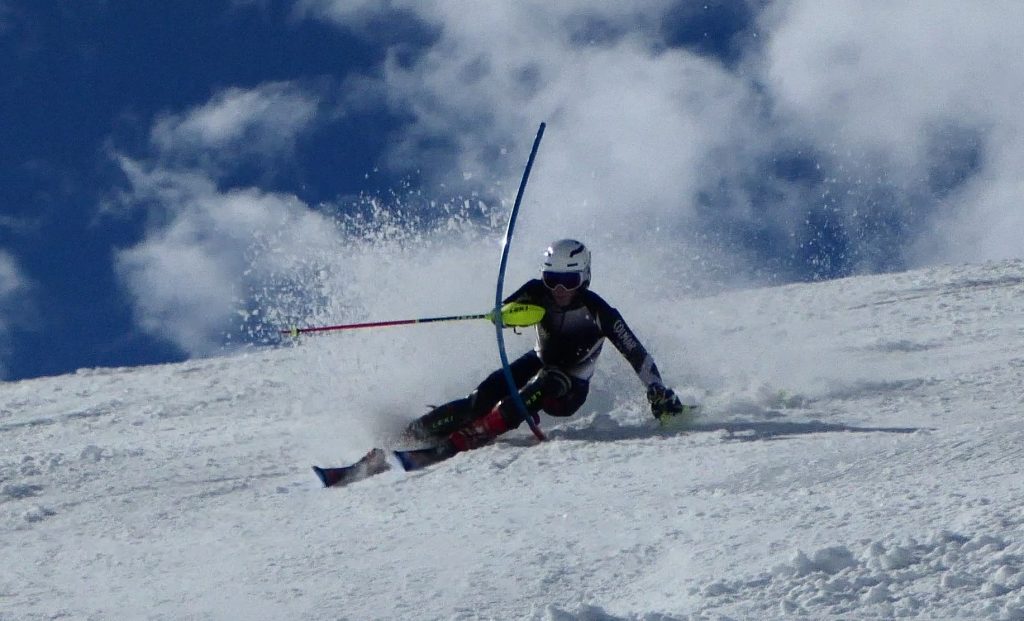Danielle and Inesz are both good skiers who clearly enjoy their skiing but wanted to strengthen their skills for tackling difficult off piste. Both have learned skiing through conventional teaching which by its nature causes skill development to plateau – so today was about getting off that plateau.
If there had been deep powder snow available it would have been a different sort of day! It’s very hard to resist the temptation to just have fun in deep powder!
Checking their skiing before starting It was clear that both were pushing their ski tails outward during the turns. Weight transfer to the outside ski was being used instead of dynamics of the centre of mass (CoM) into the centre of the turn. Pressure was more on the backs of the skis than on the fronts. There was no hip angulation and the shoulders were trying to face downhill. Inesz was also tending to stem the outside ski to find the inside edge. The following is a summary of the subjects we tackled…
Dynamics
- Start
- Development
- End of Turn
- Rhythm
- Pole Touch
Angulation
- Tilting forward at the hip joint
- Protective Postural reflex
- Safely Pressure Ski Fronts.
Pivot
- Side Slip
- Pole Plant
- Centre of Mass
Dynamics
Start
Skis facing across the hill and travelling forward.
Pushing the CoM (Centre of Mass) downhill laterally to the skis – (motorbike falling into a turn analogy).
Extending the leg when pushing.
It does not matter what edge the supporting (uphill ski) is when you push – it’s even easier to enter a new turn on the outside edge than on the inside. Understanding this helped Inesz eliminate her stemming (pushing the tail of the ski out into a small snowplough). Also being on the uphill edge of the uphill ski makes stemming it outward impossible – the CoM must then move instead.
Development
As the turn develops hold the outside leg extended and strong (See racer photo below) – maintain the pushing inward.
Do not stop driving the body inward. You are generating a centripetal (inward) force.
For general/longer turns just allow the upper body to follow the skis – don’t worry about angulation.
End of Turn
Use the build up of energy at the end of the turn to allow the ski to lift up the CoM and effectively bring it out of the turn. This is the KEY to linking turns in intimidating off piste conditions.
Be mentally prepared to “fall” over the downhill ski – coming out of one turn and then body continuing into the next.
Pole Touch
The ski poles are held with the lower arms horizontal and the elbows away from the body. They are like antennas for the CoM and it’s the movement of the CoM entering into the new turn that creates a “pole touch” on the snow for feedback. Only a flick forward of the pole from the wrist is required to position it correctly.
Rhythm
The “down/up” motion of the centre of mass gives a very stable and functional rhythm that is easily identified. It’s like how a child can sense how to make a swing work or how on a BMX bike a “pump track” can be used to generate motion. There is a resonance that can be felt.
Angulation
It’s only the pelvis that faces downhill at the end of a turn – by pulling the outside hip backward during the turn completion. Remember the postural reflex – if the chest/ shoulders are faced downhill the hip joint finds itself squashed beneath the front rib cage and the postural reflex is prevented from working. Aim to feel a stretch there instead!
Angulation is mainly a tilt forward of the upper body at the hip joint – on one leg – and then a swinging of the whole upper body toward the outside of the turn (in addition to the pulling backward of the hip joint). This must be combined with dynamics though – see how low the skier in the photo below is.
Without both angulation and driving the CoM deep down into the turn it is dangerous to have weight on the fronts of the skis. Off piste in deep snow with proper off piste skis the most stable skiing is when hard on the fronts of the skis and boots – but this requires the COMBINATION of dynamics and angulation!
Pivot
Use this link to look through the development of pivoting skills…
http://madeinmountains.com/pivo/
Pivoting is when the skis do not travel forward across the hill – they are always on their uphill (braking) edges and speed is properly controlled in the fall line.
The CoM dynamics is specifically controlled by planting the pole firmly downhill and putting weight on the pole. Skiing on the uphill edges keeps the body almost vertical all the time instead of perpendicular. This is desirable in deep soft snow (looks like sitting back!!!) and for life preservation in steep couloirs.

Today’s views…



